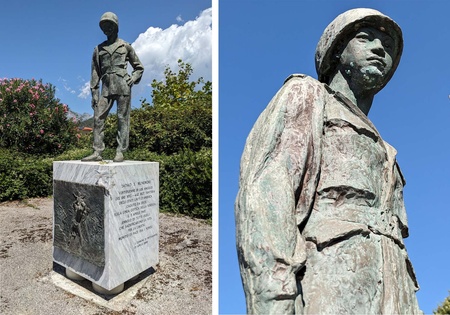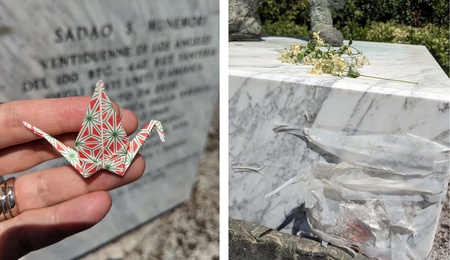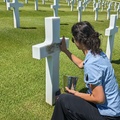Dear Grandpa,
I remember you telling me a little bit about what you did in the war. I remember you saying it was depressing, that you had to collect your injured and dead comrades from the battlefields in the mountains in Italy. That’s about all I remember you saying.
I never asked you about it, and you never offered more. I probably didn’t think to inquire. But now that you’re gone, I wish I knew more. So I went to Italy to try and see where you may have been during the war, to try to understand and appreciate your sacrifice, and to pay respect to your comrades who didn’t make it home.
There is a statue of a Nisei soldier in a town in Tuscany, Italy. Pietrasanta, translated to Holy Stone, has its origins in the 13th century. It is a beautiful town, full of beautiful people, nestled between the mountains in the Apennine Range and the Mediterranean Sea. A tourist destination for wealthy Italians, French, and Germans.
Women carry their designer dogs in their designer handbags, men wear loose linen shirts and pants with their loafer shoes. Even the children are dressed in high fashion–the toddler boys in polo shirts, young girls in pressed white dresses. At the beach not far from the center of town, women wear large necklaces and earrings and bracelets while they sunbathe in string bikinis under private umbrellas they have rented for the season.
I felt out of place there, uncomfortable even, as I walked in my flip flops to the grocery store to buy peanut butter and bread because I could neither afford nor understand the four course Italian menus.
Most people were in Pietrasanta on vacation, to take in the art galleries and drink wine, or perhaps buy some marble decor. I was there to hike in the mountains. And to see a statue.
It was a hot day in August; I found my way through the town’s historic center, where narrow streets are decorated with terracotta and green and yellow-colored three-story apartments, ristorantes, and wine bars. I walked past the quaint gelato shops and expensive marble and bronze art galleries. I headed away from the mountains, toward the ocean, past the supermarket, through a dirt alleyway, through a residential neighborhood. The sound of cicadas from the tall trees drowned out the sound of the cars and motor scooters.
I looked down at the map on my phone to make sure I was going in the right direction. When I looked up again, there he was. A small plaza bordered with trees and shrubs mostly hid the tall, silent figure. I walked around to a gravel path that opened up to a lone statue.
I approached him and felt the sun splash my skin as I lifted my face to see him better. Cast in bronze, his green and grey body stood tall on a white marble pedestal. His name was Sadao S. Munemori, and he was from Los Angeles.
His family was incarcerated at Manzanar, and he was twenty-two years old when he was killed by a German grenade in 1945. It bounced off of his helmet, and when it landed, he dove onto it, covering the blast and saving two of his nearby comrades in the Italian mountains behind us. For his heroic sacrifice, he earned the Medal of Honor.
Sadao Munemori trained at Camp Shelby, like you did, Grandpa, and I wonder if maybe you knew him. Perhaps he was your friend. Perhaps you talked about football, shared photos of your family with each other, drank beers together. Maybe you helped carry him down the mountain. Perhaps you cried a little when he died.
On top of the marble pedestal, several yellow flowers from a nearby shrub had been laid at his feet. They looked fresh. Someone had placed them there. Then my eyes were drawn to what appeared to be taped plastic on the pedestal. I looked closer. Why would someone tape plastic to the marble base? I gently peeled away the tape and could see a notepaper folded into the plastic.
Someone had left a letter for the soldier!
What should I do, I wondered. Opening it would feel like eavesdropping on a private conversation. But who would leave a note, and why, and what would they say?
My curiosity got the best of me and I carefully removed a section of tape and pulled out the note. I unfolded the paper, but to my disappointment, it was blank. Just the lines from the notebook were there.
Who would go to the trouble of leaving a blank note wrapped and taped in plastic at the foot of a Japanese American soldier in a small town in Italy? Was it the same person that left flowers at his feet? And what did they want to say in the note? Had their message been erased by time and weather? Or was it always blank?
Perhaps the letter was symbolic–there are no words to express gratitude for the soldier’s sacrifice. These are questions I would not be able to answer.
I opened up my wallet and took out an origami crane that I had folded. I returned the blank note along with the crane to the plastic, and walked back to my apartment.
On our last day in Pietrasanta, I went back to the statue. I had been intrigued by the blank note and the fresh flowers. I couldn’t stop thinking about who may have left them. Did the statue have a caretaker? A friend? A lover? What was their story? Would they return and find my crane and wonder who left it? Would they wonder if it was a message from the soldier? Would they find comfort in it? I had to go back and see if anything had changed.
When I returned, the yellow flowers were gone. Perhaps carried away by a breeze. The crane and the note covered in plastic were still there. They appeared untouched. I looked around the plaza to see if anyone was watching. I saw nobody. So I left the soldier some new flowers. I placed pink ones and yellow ones in a crevice in his shoe, hopeful that they wouldn’t blow away.
I thought about the soldier’s sacrifice in the mountains that stood behind him. It made me sad to think that he doesn’t have a granddaughter that could have been my friend. I thought about how lucky I was that you were able to come home, Grandpa. Injured, but alive.
I stepped back, and like my dad had taught me, I saluted the soldier and walked away.
Thank you for your service, Grandpa.
Love,
Lena
To be continued ... >>
© 2023 Lena Newlin






